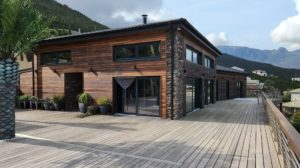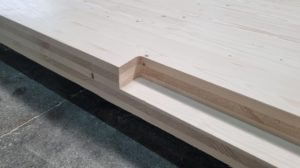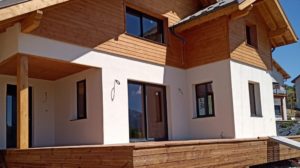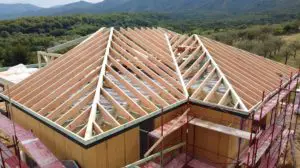After the interior and exterior walls, windows were installed, the roof was erected and the terrace was built at the Lake House. You can find the previous steps - the foundation and erection of the exterior and interior walls - on drumulsprecasa.ro, where the project is presented in detail, including photo and video images taken by the owner. The project is a passive house built by Litarh in Pantelimon, near Bucharest, for the Iosif family. For a passive house - which is the highest level of energy efficiency - putting up the windows and raising the roof are very important steps. Not that they are not important for other types of house, but these areas are very sensitive in terms of thermal bridges and heat loss, and the smallest deviations can cause the house to fall outside the passive house parameters. The video of this step is at the end of the article.
Passive house windows must meet certain standards
The parameter used to determine the performance of a window is called heat transfer coefficient which, as with thermal insulation, is measured in W/m²K. The lower it is, the better the window performs, providing good insulation from the outside. For passive houses, the heat transfer coefficient must be less than 0.85W/m²K. The window consists of a frame and a glazed part, each made of different materials with different thermal coefficients. For passive houses, each of these materials must have a heat transfer coefficient below 0.85W/m²K.
Windows energy efficient houses are glazed with two or three layers of glass. Between them is dry air or inert gas (argon or krypton) to reduce heat transfer. The glass used is of high quality, durable, of uniform thickness and may contain UV absorbers. Strips are placed between the layers of glass to keep the spacing constant even with variations in atmospheric pressure. The strips prevent the accumulation of moisture or leakage of inert gas from the interior. Passive houses use windows made of three layers of glass, with a total thickness of 40-50 mm, which are very energy efficient. The glass is fitted with foils that store heat and release it when the inside temperature drops.
Installation is also very important, as the area around the windows is the most prone to thermal bridges. In passive houses, windows are fixed in place using narrow foils that are glued both inside and outside. The foils glued around the window continue to insulate the wall, preventing energy bridges.
Shading elements are also very important and can be fitted with intelligent systems that open and close them according to the amount of light and heat outside.
Roof and terrace construction
Under the supervision of design engineer Constantin Tudosă, the Litarh team built the roof according to the same rules imposed by the passive house standard. Studies have shown that the greatest heat loss occurs through the roof, which is why the insulation layer must be thicker than the walls (in passive houses, min 15-20 cm in the walls and 25-30 cm in the roof). To minimize thermal bridges, the foil was installed continuously, without interruptions or punctures. The DVD boards ensure the elimination of condensation, the vapor circulation being in one direction only, from inside to outside.
The terrace was also built at this stage. It only took one day to fix the posts, the beam and the rafters. The posts were fixed with feet so that they would not come into direct contact with the concrete and draw moisture from it. It is no news that wood is water-loving. In order not to absorb water at risk of rottingWood is not mounted directly on the ground or concrete. Another important factor is air circulation, which ensures that the wood is able to move if it has been soaked by rain. The feet with which the posts are fixed also serve this purpose, to leave a space through which air can circulate.
In the video below you will see the features of passive house windows, their installation and the roof height.




































Add comment